Miccosukee Tribe of Indians - Everglades Cooperative Invasive ...
Miccosukee Tribe of Indians - Everglades Cooperative Invasive ...
Miccosukee Tribe of Indians - Everglades Cooperative Invasive ...
You also want an ePaper? Increase the reach of your titles
YUMPU automatically turns print PDFs into web optimized ePapers that Google loves.
<strong>Miccosukee</strong> <strong>Tribe</strong> <strong>of</strong> <strong>Indians</strong>Steve Terry, Land Resources ManagerRory Feeney, Fish and Wildlife Director
Priority Plant Species• Priority Plants– Brazilian pepper– Melaleuca– Old World Climbing Fern• Newly Detected Plant Species– No significant detections
Mechanical Removal <strong>of</strong> Melaleuca at <strong>Miccosukee</strong> Resort and Casino• Objective• To remove the thick melaleuca from the property so that thesurrounding wetlands can be restored.• Partners• Start/End Dates• Summer 2006 - ongoing• Status• Ongoing dependent upon the how wet the area is and the muck.• Funding (FY): Tribally Funded• Annual Summary• Almost all <strong>of</strong> the 179 acres that make up the back portion <strong>of</strong> the ResortProperty, and approximately 150 acres on fee property adjacent to theResort.
Digital Aerial Sketch Mapping<strong>Miccosukee</strong> ReservationMelaleucaCoverage Class AcresHigh 0Medium 42Low 3
Digital Aerial Sketch Mapping<strong>Miccosukee</strong> ReservationBrazilian PepperCoverage Class AcresHigh 70Medium 477Low 533
Digital Aerial Sketch Mapping<strong>Miccosukee</strong> ReservationOld World Climbing FernCoverage Class AcresHigh 0Medium 0Low 7
Planned Treatments
Priority Animal Species• Priority Animals– Burmese/African Rock Pythons, exotic Apple Snails,Asian walking catfish, and Cichlid sp.• Newly Detected Animal Species– Plecos
<strong>Invasive</strong> Species Programs• GIS Mapping and removal <strong>of</strong> Island Apple Snail (Pomacea insularum)• Description– The Island applesnail (P. insularum) was identified, marked with GPS and and thenphysically removed and destroyed. The area <strong>of</strong> interest was the L-29 Canal betweenthe S-12A and S-12B structures.• Objective– To gage the distribution <strong>of</strong> P. insularum and determine what type <strong>of</strong> studies are requiredwithin WCA3A.• Partners– SFWMD and ENP• Start/End Dates– July 2008 - ongoing• Status– ~70 egg clusters mapped and removed. P. insularum has been observed in WCA3A.• Funding: n/a• Annual Summary– The extreme cold weather in February/March may have played a role in the lowobserved numbers. Possible affect on reproduction or shift in season. Additionalsurveys will be conducted in the coming months.
<strong>Invasive</strong> Species Programs• Exotic python reporting and public outreach program• Description– The Burmese python (Python molurus bivittatus) population has become a wide spreadproblem in south Florida; particularly near the <strong>Miccosukee</strong> Reservation. The Tribal communityand department staff have been responding to live python reports and road kills along US41,Krome Ave and Water Conservation Area 3A South.• Objective– To gage the occurrence and distribution <strong>of</strong> Burmese pythons, suppress the expandingpopulation, and provide community education/awareness.• Partners– FWC, SFWMD and ENP• Start/End Dates– 2007 - ongoing• Status– 12 pythons reported during the past 6 months. Probably only a fraction <strong>of</strong> actual sightings.Several +12’ pythons found along the L-28 tieback levee. Most active during Spring morninghours. African rock pythons found in the Bird Drive Basin.• Funding: n/a• Annual Summary– Road kill reports have been reduced and the overall number <strong>of</strong> observations have decreased.– Several large pythons were found dead in WCA3A <strong>of</strong> apparent cold stress.
<strong>Invasive</strong> Species Programs• Viable Fisheries Resources for the <strong>Miccosukee</strong> <strong>Tribe</strong>• Description– Methyl mercury bioaccumulation has become an increasing problem in the fresh waterecosystem <strong>of</strong> South Florida. The Hg in the native fish and the presence <strong>of</strong> exotic species haveimpacted the <strong>Miccosukee</strong> traditional way <strong>of</strong> subsistence fishing.• Objective– The <strong>Miccosukee</strong> <strong>Tribe</strong> is attempting to develop a mercury safe fishery in the closed section <strong>of</strong>the Old Tamiami Canal that is sustainable for recreational, subsistence and cultural use byTribal members.• Partners– Nicholls State University• Start/End Dates– 2006 - ongoing• Status– Exotic fish (i.e. oscars, catfish and african cichlids) were found dead throughout the L-29, L-28,and Old Tamiami Canal systems due to cold shock. Native fish impacted as well (bass, snook).– Since last year Florida native fish have been restocked in the Old Tamiami Canal including: RedEar, Blue Gill, Large Mouth Bass and Florida Gar. Additional mercury safe brim, bass, and garwill be phased in over the proceeding months.• Funding: n/a• Annual Summary– The <strong>Tribe</strong> is ready to proceed in the implementation <strong>of</strong> the <strong>Miccosukee</strong> Fishery ManagementPlan which is an indispensable tool to restore the fishery resource and preserve the social,subsistent and cultural values for the long term benefit <strong>of</strong> the <strong>Tribe</strong>.
Exotic species found:Mayan cichlidsOscarsTilapiaGrass CarpWalking catfishPlecostomus sp.
Planned Treatments
NEEDS?
Questions?• stevet@miccosukeetribe.com• roryf@miccosukeetribe.com• (305)223-8380• PO Box 440021 Miami, FL 33144
















